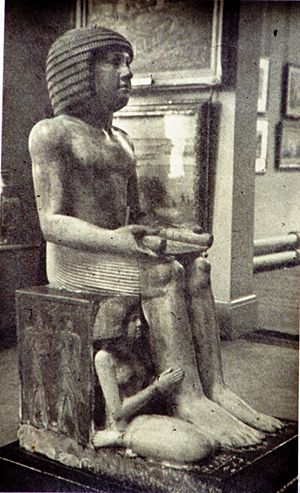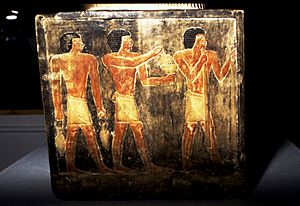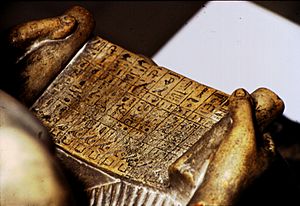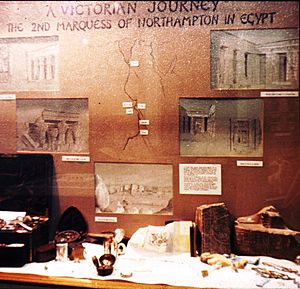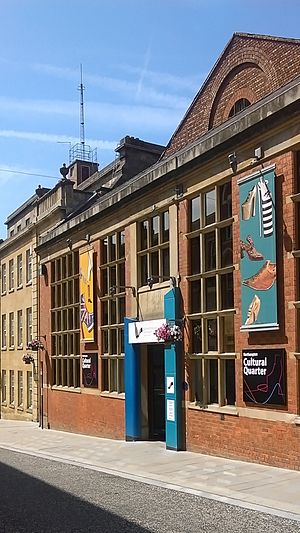Northampton Sekhemka statue facts for kids
Quick facts for kids Northampton Sekhemka statue |
|
|---|---|

Statue of Sekhemka
|
|
| Height | 75 cm |
| Width | 43 cm |
| Created | c. 2420 BC |
| Discovered | c. 1850 |
The Northampton Sekhemka statue is an amazing ancient Egyptian artwork. It was given to the Northampton Museum around 1870 by the Marquess of Northampton. This statue is very old, dating back to the 5th dynasty of Egypt (around 2494–2345 BC). That makes it even older than Stonehenge!
The statue shows an important Egyptian scribe named Sekhemka with his wife, Sitmerit. In July 2014, the statue was sold, which caused a lot of discussion. People wondered if the museum had the right to sell it and if it was the right thing to do. The statue was sold for a huge amount of money, £15.76 million, which was a world record for ancient Egyptian art sold at an auction. Because of this sale, Arts Council England removed Northampton Museums' special accreditation on August 1, 2014. They said the sale didn't follow the rules for how museums should manage their collections.
Contents
- What the Sekhemka Statue Looks Like
- Where the Statue Came From
- Why the Statue's Sale Was Controversial
- Safety Concerns for the Statue
- What People Thought About the Sale
- Agreement Between the Council and Lord Northampton
- Protests Against the Sale
- "The Curse of Sekhemka"
- The Auction Day
- What Happened After the Sale
- Museum Loses Its Special Status
- Friends Group Disbands
- Export License Refused
- Group Claims Sale May Have Been Against Rules
What the Sekhemka Statue Looks Like
This statue shows Sekhemka sitting in a special pose, like a scribe ready to write. He holds a partly unrolled papyrus scroll on his lap. This scroll lists different offerings. An inscription on the base of the statue names him as "Inspector of Scribes in the House of Largesse." This means he was an important person who managed writers.
His wife, Sit-Merit, is shown sitting at his feet. The statue is made of limestone and stands about 75 centimeters (30 inches) tall. Its base is about 43 centimeters (17 inches) from front to back. An archaeologist named Mike Pitts took many detailed photos of the statue when it was displayed before the auction.
Where the Statue Came From
The exact story of how the Sekhemka statue arrived in England is not completely clear. One idea is that the Northampton Museum got it in 1849 from the Ottoman sultan. Another story says that the 2nd Marquess of Northampton got it during a trip to Egypt in 1850. His son then gave it to the Northampton Museum around 1870.
Records from 1899 suggest that the 2nd Marquess likely acquired the statue during his trip. However, the museum didn't have very precise information about how they got the statue.
Why the Statue's Sale Was Controversial
The Northampton Borough Council, which runs the museum, found out how valuable the Sekhemka statue was in 2012. They then started making plans to sell it. They wanted to use the money to fund other projects in the area, like improving the museum.
The council leader at the time, David Mackintosh, said the statue had been owned by the museum for over 100 years but was "never really the centerpiece." He explained that they wanted to expand the museum and needed to raise money for it. The council suggested using the money from the sale to restore Delapré Abbey and improve museum services. However, the Museum Association asked them to stop the sale. They wanted the council to make sure selling the statue was truly the "last resort."
Safety Concerns for the Statue
The council said that after the statue was valued in 2010, it was taken off display because of safety worries. They claimed it would need security guards 24 hours a day. However, an insurance company later said that the display case the museum used was actually "adequate." People also asked why the council didn't accept an offer of £8,000 from a local group to buy a new display case. The council did not answer this question.
What People Thought About the Sale
In October 2012, the council shared the results of a petition. This petition asked the council to rethink selling Sekhemka. It warned that selling the statue could harm Northampton Museums. It also said it went against what the original donors wanted. People worried the museum might lose its special status and access to important public funding.
The council said they asked the public for their opinions on the sale in January 2013. However, the way they did this was criticized. The questionnaire only asked people where the money from the sale should go. It didn't ask if the statue should be sold at all. It also didn't recognize how important the statue was to the museum's history.
Even so, the BBC reported that the council claimed 51% of 173 replies were in favor of the sale. But the Save Sekhemka Action Group, which wanted to keep the statue, said the council's survey methods were unfair. They launched their own survey, which showed that most people wanted to protect the museum's status and keep the statue. A local newspaper also did a poll on Facebook, and most people wanted to keep the statue.
Agreement Between the Council and Lord Northampton
The current Lord Northampton first disagreed with the council's decision to sell the statue. But after a year of talks, he made a private agreement with the council. This deal meant he would receive £6 million from the sale. The council has not shared the details of this legal agreement.
In June 2014, the council said that 55% of the sale money would go to the council and 45% to Lord Northampton. They also stated that lawyers confirmed the council owned Sekhemka and had the legal right to sell it. After the sale, the Save Sekhemka Action Group questioned why Lord Northampton would get so much money if the council truly owned the statue.
Protests Against the Sale
The Egyptian Ministry of Antiquities asked the Egyptian Embassy in London to try and stop the sale. They said selling the statue went against what museums should do. Museums should share culture, not just make money. They also asked the International Council of Museums (ICOM) to stop the sale for ethical reasons.
The Museum Association for the United Kingdom warned the council that Northampton's museum membership would be reviewed if the sale went ahead. The Arts Council of England also said the sale could put the museum's special accreditation at risk. This could limit the museum's ability to get grants in the future.
An archaeologist named Andy Brockman, who was part of the Save Sekhemka campaign, said the sale would "bring Northampton Council into disrepute." He added that museum experts were against the sale. They wanted to make sure no part of Egypt's cultural history was sold off.
Experts from ICOM CIPEG said that selling artifacts to pay for museum costs goes against ethical rules. They were worried that a famous Egyptian artwork might disappear into a private collection. This would make it impossible for the public, students, and scholars to see it. They urged the council to stop the sale. They also worried that the sale might encourage illegal digging and stealing of ancient Egyptian treasures.
"The Curse of Sekhemka"
Some people joked about a "Curse of Sekhemka." In July 2013, a local politician who was against the sale said that if there was a curse, it should fall on the council for not changing their minds. The day before the auction, the estate office of the Marquess of Northampton's Castle Ashby caught fire. This led to more stories about the "Curse Of Sekhemka."
The Auction Day
Christie's auction house sold the Sekhemka statue for £15.76 million on July 10, 2014. The buyer was kept secret. A protester briefly stopped the auction, shouting that no one should bid on "stolen property." A small group of Egyptian protesters also demonstrated outside. The final price was much higher than Christie's expected. It broke the world record for an ancient Egyptian artwork sold at auction.
What Happened After the Sale
The Save Sekhemka Action Group called the sale a "day of shame for Northampton." They said it was one person's decision, made against all expert advice. The Egyptian Embassy called the sale a "shameful and unethical act."
Scott Furlong from Arts Council England said it was disappointing that the council went ahead with the sale before discussions were finished. David Mackintosh, the council leader, said the council's share of the money would be used to improve the museum. The writer Alan Moore also spoke out against the council's decision.
The The Art Fund said that selling items for money should only happen in very special cases. They said the money should directly help the museum's collection, and only after all other options are tried. They believed this was not the case with Sekhemka. They warned that the museum might lose its special status. This would mean the museum would not be able to get funding from them and other major organizations for new items, building projects, or educational programs.
The Arts Council announced on July 24, 2014, that Northampton Museums' accreditation would be reviewed. They said it was disappointing that the council sold the statue. They stressed that the public needs to trust museums to care for shared heritage. They worried that this trust could be damaged if sales are driven by money.
Museum Loses Its Special Status
On August 1, 2014, Northampton Museums lost their accreditation from Arts Council England. This meant the sale broke the rules for how museums should manage their collections. Because of this, the museums could no longer get funding from many arts grants and funding groups. They were excluded from participating in these programs until at least August 2019.
Scott Furlong of the Arts Council said it was sad to exclude a museum. But he added that it was important to uphold the standards that most museums follow. David Mackintosh, the council leader, called the decision "disappointing" and "puzzling." He said Northampton was one of the few local authorities planning a big investment in its museum service.
The Save Sekhemka Action Group said it was a "black and shameful day for Northampton's Culture and Heritage." They believed it would lead to the decline of both the Central and Abington Museum. They said the money lost from not having accreditation would likely be more than the £8 million the council got from the sale.
In November 2014, the council's request for a grant of £240,400 was turned down. This was because they no longer had Arts Council accreditation. The money was for an exhibition of designer shoes. The council said they were "disappointed." The Museums Association also banned the council from membership for five years.
Friends Group Disbands
In September 2014, the Friends of Northampton Museums and Art Gallery decided to close down. This group had supported the town's museums for 55 years. The sale of the statue was partly why they disbanded. The group was against the sale, even though some felt it wasn't part of their main purpose.
Export License Refused
On March 30, 2015, the British culture minister, Ed Vaizey, put a four-month temporary ban on exporting the statue. It had been sold to a buyer overseas, possibly in America. The Arts Council said there was a chance the statue could be sold to a UK buyer if someone seriously tried to raise the recommended price of £15,732,600 plus tax.
On October 2, 2015, Vaizey extended the export ban until March 29, 2016. This was because there was a serious attempt to raise money to keep the statue in the UK. However, no one made a counter-offer during this time. In April 2016, the ban was lifted. The current location of the statue is not known.
Group Claims Sale May Have Been Against Rules
On April 21, 2015, the Save Sekhemka Action Group said they believed the original gift of the statue might have included a rule that it could never be sold. If true, this would make the auction against the rules. The group said they didn't want to buy the statue back. Instead, they suggested it should be displayed in a major museum. They also questioned why Lord Northampton's family received £6 million from the sale. They planned to look at council records to understand the agreements made with the Marquess of Northampton.
The BBC reported in October 2016 that the statue is now thought to have been sent to the United States. BBC news also revealed that the council, which made £8 million from the sale, had been warned by lawyers not to sell it just for money. The council said it sold the statue to help fund a £14 million expansion of its museum and art gallery.


